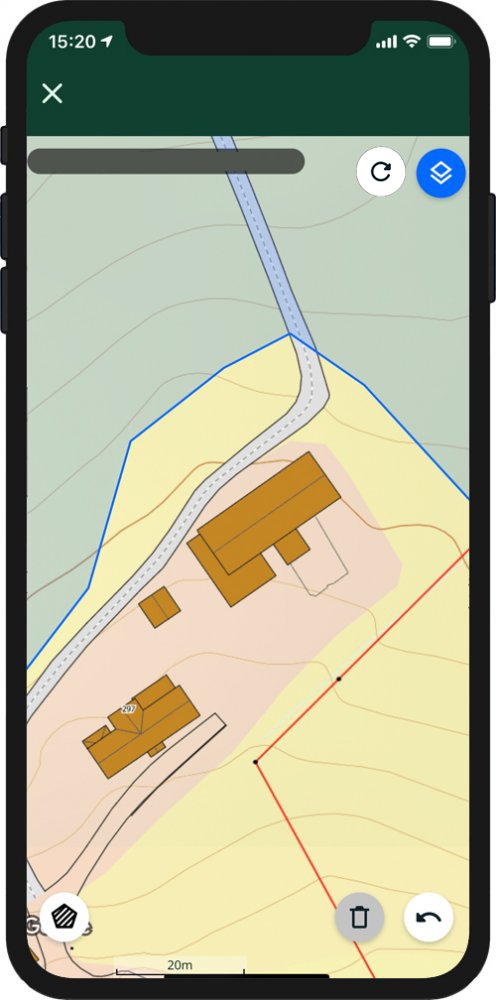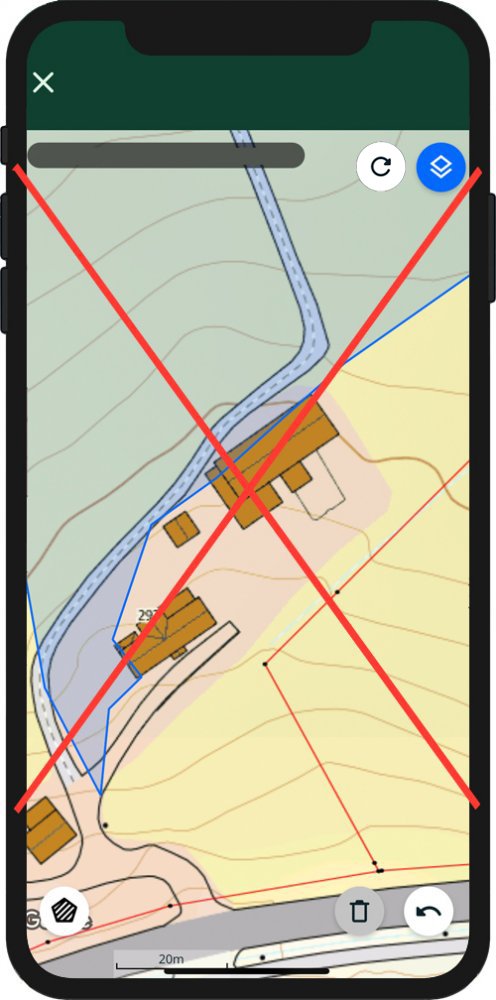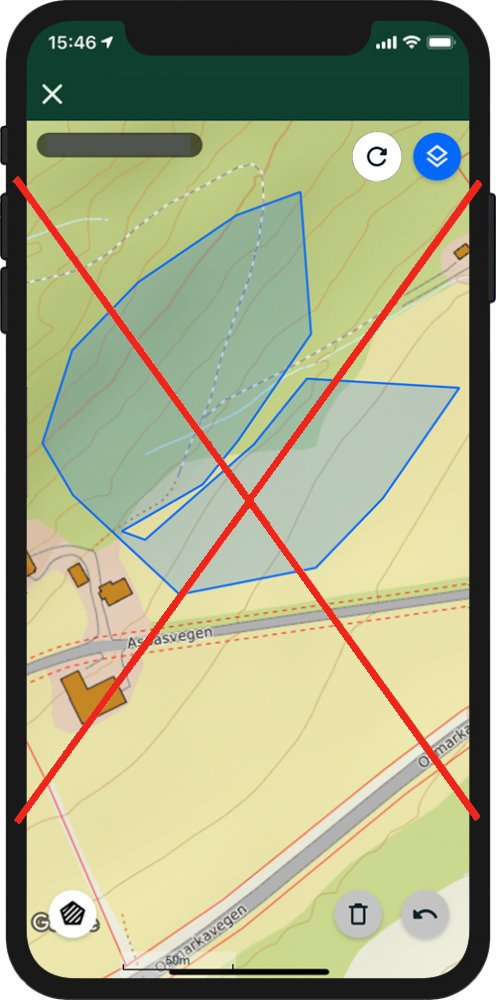Creating pastures with Nofence is easy. With just a tap on the screen you can place virtual fencing posts wherever you want in the terrain, regardless of slope and ground conditions. However, an easy pasture is not necessarily a good pasture for your animals. In this section, we have gathered our recommendations to help you optimize your pasture design.
A well-designed pasture should have:
- Sufficient space. The animals should have enough space. Four goats in a 50mx50m area is too small.
- Access to food and water. A lack of access to food and water may cause the animals to escape from the pasture.
- Angles of 90 degrees or more. Sharp corners or narrow corridors may confuse the animals.
- A design that maintains the animal’s natural instinct.
- A safe distance from dangerous areas in the environment. The pasture boundary is where the audio warning starts, not where the animal stops to turn around.
- Appropriate fencing in areas with buildings or barns. Avoid GPS shadows or drifting by leaving a fair distance between the obstacles and the pasture boundary.
Below, we have outlined some of the points above on a deeper level. The illustrations demonstrate good and bad pasture design. Please be aware these illustrations are general. It is important to use your own knowledge about your own pasture and animals to design good pastures that are suitable for your use.
Sufficient space
There are can be great variations in topography, number of buildings in the pasture, access and quality of feed, number of animals in the pasture, etc. It is, therefore, difficult to have a standard recommendation on how large a pasture should be or the stocking density. However, the pasture should be big enough so that the animals can turn around after crossing the boundary, without interacting with the boundary again straight after turning around. The distance between the boundaries should therefore be more than 25 meters. Animals that are still learning the system should have more space than animals that have used the system for a longer period of time.
The animal’s instinct
It is important to be aware that sometimes the animal’s instinct can be stronger than the desire to avoid the electric pulse. If the pasture does not satisfy the animal’s basic need for food and water, they may escape.
Nofence allows you to split herds into different pastures. You need to consider the animal’s instinct if you wish to be successful in splitting herds. The herd instinct varies between animal type and breed. When the herd instinct is strong, keeping animals apart becomes increasingly difficult. The different pastures should have enough distance in between them so the animals in the different groups cannot see, hear or smell each other.
Fencing close to buildings
As described in “GPS/Positioning’‘, walls can affect the GPS signal and cause it to be less accurate. The first illustration below shows the Nofence boundary placed at the same line as the house wall. In this case, you will experience that the animal can cross the pasture boundary without receiving any warnings. This is because the building affects the GPS signal, and with an inaccurate GPS position, the collar will not give any audio warnings or pulses. However, when the animal gets out in a more open area, the GPS accuracy will increase and the warnings will start.
In the second illustration below, the Nofence boundary is left with more space from the building, and there is no risk of the GPS signal being affected.
Pastures close to the farm yard
If you want the animals close to the barn, but not in the farm yard, it may be an option to combine the Nofence boundary with a physical fence. In the illustration below, we have left the virtual boundary far from the farm yard, and marked in red where it would be appropriate to leave the physical fence.
Inappropriate use of Exclusion zones
Make sure that the different exclusion zones have enough distance between them. If the distance is too short, you may risk that the animals become trapped between two boundaries, and have trouble maneuvering their way out. Since the GPS positions always have a certain inaccuracy, we recommend at least 25 meters between the boundaries. In the illustration to the left, a line of trees has been excluded by leaving an exclusion zone for each tree. A better solution here is to create one large exclusion zone for all the trees. This makes it easier for the animals to understand.
Fencing close to dangerous areas
If the pasture is located close to a dangerous area that you do not want your animals to access, like a busy road, it is important to leave the Nofence boundary with enough distance from it, so that the animals turn around before they reach the dangerous area. A good idea can be to take a single collar and test where the audio warning starts. If a dangerous area is at the bottom of a hill, we recommend placing the Nofence boundary further up the hill. The animals will often be traveling faster as they move downhill and therefore may move towards the boundary more quickly, which can increase the distance of the Nofence boundary zone.
Narrow pastures
Below, you can find three different examples of narrow pastures. In the illustration to the left, the pasture has a narrow corridor in between it. If some animals are on one side of the corridor, and other animals on the other side, they may cross the corridor just to get to the rest of their herd.
Pastures with a narrow design may confuse the animals as they will meet the pasture boundaries wherever they move. After the training period, the animals have learned to turn around on the audio warning. Therefore, they should not meet a new audio warning after doing as they have learned. Narrow pastures can also lead to GPS inaccuracy when the animal is laying still and resting, something that may lead to audio warnings and electric pulses inside the pasture. Remember that experienced animals can handle narrow pastures better than animals that recently have been introduced to Nofence.
Tip:
Avoid corridors or pastures narrower than 25 meters. Rather combine Nofence with physical fences on one side of the pasture. If the pasture goes along a sea, you can leave the pasture boundary out in the water. This way, you can save battery life-time.
Knowledge-based adjustment of the pasture boundary
In the app or in the grazing map in your account, you can find an overview of the animals movement patterns. You can also view where the animals have received audio warnings and electric pulses. We recommend using this information to identify areas where the pasture boundary should be adjusted. Also when an animal escapes, it is important to investigate the cause of it. This way, it can be prevented from happening again.












